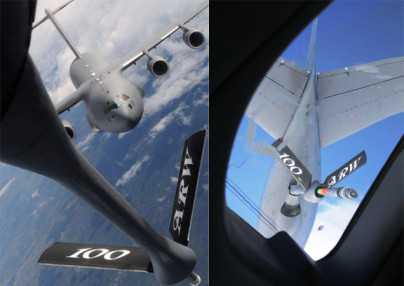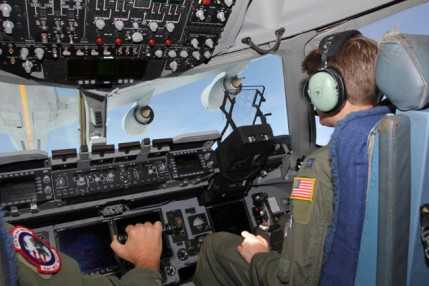Keep Calm and Refuel
Szöveg: honvedelem.hu / heavyairliftwing.org | 2013. október 19. 6:02Air refueling operations are everyday business for air forces needing to reach distant locations worldwide without the possibility of landing for refueling. Filling up in the air is also an important skill for the C-17 aircrews of the Strategic Airlift Capability Heavy Airlift Wing. According to 1Lt Nikolay Chaprazov, a HAW C-17 aircraft commander, a successful refueling mission is an outcome of good training, coordination, and a calm attitude towards the demanding task.
Air refueling, in other words delivering fuel to flying aircraft with a dedicated fleet of air tanker planes, is an essential part of increasing the mobility of air forces worldwide. According to 1Lt Nikolay Chaprazov, a Heavy Airlift Wing C-17 Aircraft Commander of the Bulgarian Air Force, air refueling can be used to support a variety of air operations both in the times of peace and crisis.

“In a combat scenario air refueling allows you to stay up there for longer times, allowing you to carry out longer missions and avoid possibly dangerous landings for refueling. In peacetime military airlift it can be used to extend your reach or to increase the amount of cargo an aircraft can take off with. If the aircraft needs to be loaded close to its maximum takeoff weight with limited capacity left for fuel, some extra fuel needed on route can be taken from an air tanker only after takeoff.
In most of the modern day fighters and military cargo planes the provision to receive fuel from an air tanker
is built in to the systems of the aircraft. This is also the case with Boeing C-17 Globemaster III, a cargo jet known for its versatility. In order to make the most of this capability, the multinational HAW aircrews fly operational and training air refueling missions regularly.
1Lt Chaprazov, who himself has flown several dozen air refuel missions with SAC C-17s, describes air refueling as a procedure that is regarded to be very demanding.
Therefore the procedure of connecting with a tanker and receiving fuel can be carried out only by the C-17 mission commander with special training and a flight experience of several hundred hours
on the type. Also keeping proficient in air refueling requires a lot of effort.
“According to regulations, a pilot needs to perform an air refueling flight every 45 days and a total of six
flights in a period of six months to keep current. This amount is so high that usually we don’t get enough
opportunities to do this on operational missions. Therefore also separate dedicated air refuel training missions need to be flown."
In the multi-national SAC program the training flights are usually carried out in cooperation with some of the SAC partner nations that operate tanker aircraft.
Usually the aircraft participating in the training depart from their home bases and meet with the HAW C-17 either over SAC host nation Hungary or their home country. After the training is finished, everyone returns
to their bases.

As 1Lt Chaprazov points out, this arrangement is an efficient way of sharing capabilities and knowledge
together.
“We do our training usually with United States Air Force KC-135s stationed in Europe or KDC-10s of the Royal Netherlands Air Force. This gives us mutual benefit since both HAW crews and the tanker aircrews need to do their missions to keep current".
But what is it that actually makes air refueling as demanding as it is? The answer is the combination of
complicated procedures and individual pilot skills that are needed to make it safe and efficient.
“The procedures for air refuel are determined in close detail by operational instructions" Nikolay Chaprazov
says, “The rendezvous point with a tanker is approached according to a certain procedure and the
terminology used between aircraft in radio communications is predefined."
After the C-17 and the tanker have reached a distance where they can easily visually identify each
other and it is time to make contact with the refuel boom, it is all about classic piloting skills. The huge
C-17 is steered manually to the position where it connects with the tanker’s refueling boom.
“Usually we fly at airspeeds of around 275 kts (510 kph), depending on the type of the tanker aircraft and
we approach the boom at the rate of one feet per second", Nikolay Chaprazov says.
“At that point yourjob is to try to keep the aircraft as steady as possible so that the boom operator in the tanker can smoothly steer the boom to connect it with the receiver of the C-17. The right location of your aircraft is determined by observing the approach lights on the airframe of the tanker or looking at other visual clues. After the connection is made, you need to follow the tanker through possible turning and banking for several minutes until you’ve received the desired amount of fuel".
Every pilot who has been involved in air refueling probably admits that it is always exciting to be only
tens of meters away from another huge aircraft. However according to 1Lt Nikolay Chaprazov the key to a safe and successful air refueling missions is to stay alert but not too tense behind the controls.
"When you do air refueling training for the first time or you’ve haven’t done it for a while, you may feel excited and sometimes squeeze the control stick a bit too hard. But when you overcome that feeling and keep calm, you also fly smoother. Also regular practice helps a lot. The more air refueling missions you do, the easier it becomes.